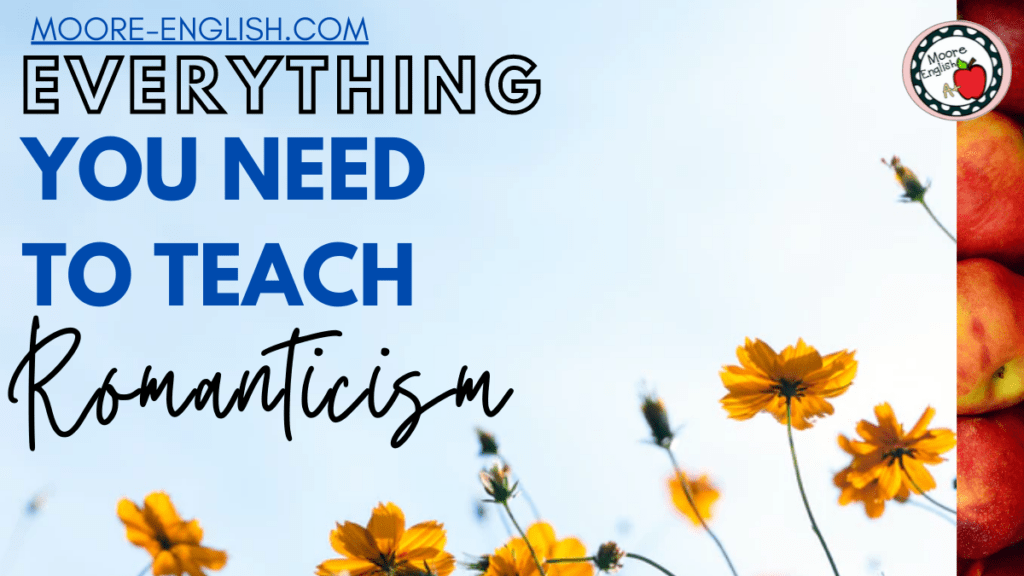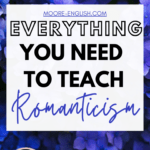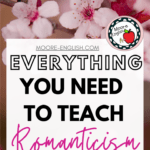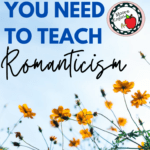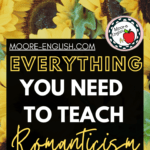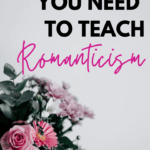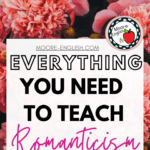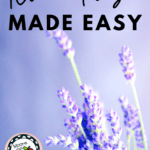For my juniors, American Romanticism is our second unit. In this unit, we have three specific goals:
- First, we focus on analyzing how an author’s choices support their purposes.
- Second, we practice evaluating how a text represents its historical context.
- Third, we synthesize across texts and media.
Do we work on other skills as we read, write, and discuss? Yes, of course we do. No part of English language arts happens in isolation; all of our reading skills connect to our writing skills, which support our speaking and listening skills. However, at the end of the unit, these are the skills most heavily assessed.
This post this post may contain affiliate links. Please read the Terms of Use.
Introducing Romanticism
For many of my students, the idea of literary movements is a fairly new concept. For this reason, I am very careful and explicit with how I introduce Romanticism.
First, I ask students to complete a quick write about this prompt: How does literature relate to history?
Then, students pair-share their responses before I adjust the question. Now, I ask: does literature affect history, or does history affect literature?
Students write-pair-share, and we discuss this question as a class. Usually, students determine that history and literature have a mutual relationship. Each one affects and reacts to the other. Good literature often responds to the world around it, and literature ever exists in a vacuum.
Next, I give a mini-lesson about the characteristics of Romanticism. I use this set of notes and quick acronym to help students remember the elements of Romanticism.
Finally, we’re ready to read some Romantic literature! I almost always begin with “To a Waterfowl” by William Cullen Bryant. It’s non-threatening, traditional in its structure, and has all the elements of Romanticism. As we read, students are able to practice the four steps for annotating poetry, identifying the characteristics of Romanticism, and analyzing author’s choice.
Analyzing Author’s Choices
In our study of Romanticism, students focus on analyzing how author’s choices support main idea or theme. Throughout the unit, students will continually practice connecting author’s choices and purpose. However, I like to choose at least two texts where our main focus is on identifying specific author’s choices and analyzing how they support main idea.
First, I often use Emily Dickinson’s “‘Hope’ is the thing with feathers-“. This text works well because Dickinson has a clear purpose. Furthermore, her choices about structure, word choice, and symbolism all support that goal. Her plain language also makes this poem approachable. Finally, Dickinson’s bird symbolism recalls the symbolic waterfowl in Bryant’s poem, meaning we can begin tip-toeing toward synthesis here. Check out my resources for this poem!
Second, my students love Edgar Allan Poe. In selecting a piece for my students, I try to choose a text that is the right length and that they haven’t already read. While my students usually know about hearts hidden in floorboards, enemies bricked into the catacombs, and ominous black cats, most of my students haven’t read “Berenice.” With this short story, we can analyze how point of view, setting, and characterization support author’s purpose. These kinds of story elements are not prominent in all poems, which is why I like to use a short story. Finally, this piece gives me an opportunity to introduce Gothic literature or the Dark Romantics! Check out my abridged and modified version of “Berenice.”
Romanticism and Historical Context
As students become more comfortable with the elements of Romanticism, we begin focusing on how an author’s historical or cultural context affects their work.
For this portion of the unit, I almost always choose to focus on Walt Whitman’s work. Focusing on one author allows students to see how historical and cultural context affects not just one piece but every piece an author writes. Moving from Bryant to Dickinson to Whitman also allows students to see how meter evolved in American poetry.
First, “America” by Walt Whitman is a great choice because it is so short yet powerful. In just a few lines, Whitman is able to capture his version of “America.” This leads students to a conversation about historical and cultural context but also about how an author’s word choices can evoke that context. Check out my lesson plan for this poem!
Second, students tackle excerpts from “Song of Myself“. Our class textbook features stanzas 1, 6, 9, 14, 17-18, 51, and 52, so those are the stanzas we read. Since this is such a long poem, I model reading and annotating with the first stanza through guided reading. Then, I break students into pairs or groups. Each group reads and analyzes a different stanza, paying special attention to how Whitman’s historical and cultural context appear in the writing. Depending on the number of students in class and/or how much time we have, I may add or remove a stanza. Find my lesson plans here.
Synthesizing with Romanticism
At the end of the day, synthesis is the most important skill students tackle in this unit. As the class continues, synthesis is the skill we will re-visit the most, so it’s important that we begin to develop this skill. For a teacher, choosing text pairings is one of the trickiest parts of teaching synthesis. Here are the text pairings that I use in our study of Romanticim:
First, “When I Heard the Learn’d Astronomer” by Walt Whitman pairs well with excerpts from “Civil Disobedience” by Henry David Thoreau. The speaker in Whitman’s poem walks out of the astronomer’s lecture, which Thoreau might describe as an act of civil disobedience. With this text pairing, students are introduced to Transcendentalism and have the opportunity to synthesize across poetry and nonfiction.
Second, I like to bring some William Wordsworth into our study of Romanticism. While Wordsworth is not American, I like to show students that most literary movements exist outside of the US and that sometimes literary movements begin elsewhere. “The World is Too Much With Us” pairs nicely with “Self-Reliance” by Ralph Waldo Emerson. Again, students have to synthesize across different media. In Wordsworth’s poem, he muses on the way humankind harms Nature, and in Emerson’s essay, he emphasizes the important of, you guessed it, self-reliance. For this reason, this text pairing leads to a great classroom conversation.
Final Synthesis Activity
At the end of the unit, I pair three texts together to help students analyze how Romantics describe Death.
As an independent assignment, students watch the Crash Course Literature about Emily Dickinson’s poetry while completing a listening guide that prepares them to read and annotate ““I heard a Fly buzz–when I died-.” This poem is short enough that students can confidently work through it independently, especially when they have the help of John Green. I either send this home as homework or use it as a station.
With Dickinson in mind, students then read “Nature” by Ralph Waldo Emerson. How students read this piece varies from class to class. It’s a more approachable text than “Self-Reliance,” so some groups are ready to read and annotate on their own or with a partner. Other times, I use software like Loom to record a lesson for students. Still other times, we read and annotate this text as a class.
Finally, we read and annotate “Thanatopsis” by William Cullen Bryant together. Frankly, this poem is too long and dense for my students to read independently. Reading and annotating this poem usually takes 2-3 class periods, but it’s always a poem students remember after they graduate.
Once we have read all three pieces, students can synthesize Romantic perspectives about Death and dying. To my mind, there is no standard more challenging than synthesizing across media, so this poetry cycle really helps students develop that skill.
Assessing Romanticism
At the end of the unit, I am obliged to give a summative assessment. My go-to assessment is to revisit our opening prompt: Using evidence from Romanticism, how does history relate to literature? I use my favorite rubric to assess students’ written answers to this question.
With this writing prompt, I like to give a cold read that students incorporate into their answer. First, “The Planting of the Apple-Tree” by William Cullen Bryant is a good candidate because its plot is fairly straight forward, and the speaker’s patriotism clearly provides historical context. Additionally, “I Hear America Singing” by Walt Whitman or the prose Preface to Leave of Grass make compelling texts for assessment.
Overall, Romanticism is a unit where my students grow tremendously as writers and readers, constantly expanding their skills as analytical thinkers. My Romanticism resources are included in my Transcendentalism or Romanticism bundles, both of which will help you save time and money! I have also put together a free unit planner to help teachers work through this unit.
What other texts do you include in your study of Romanticism?

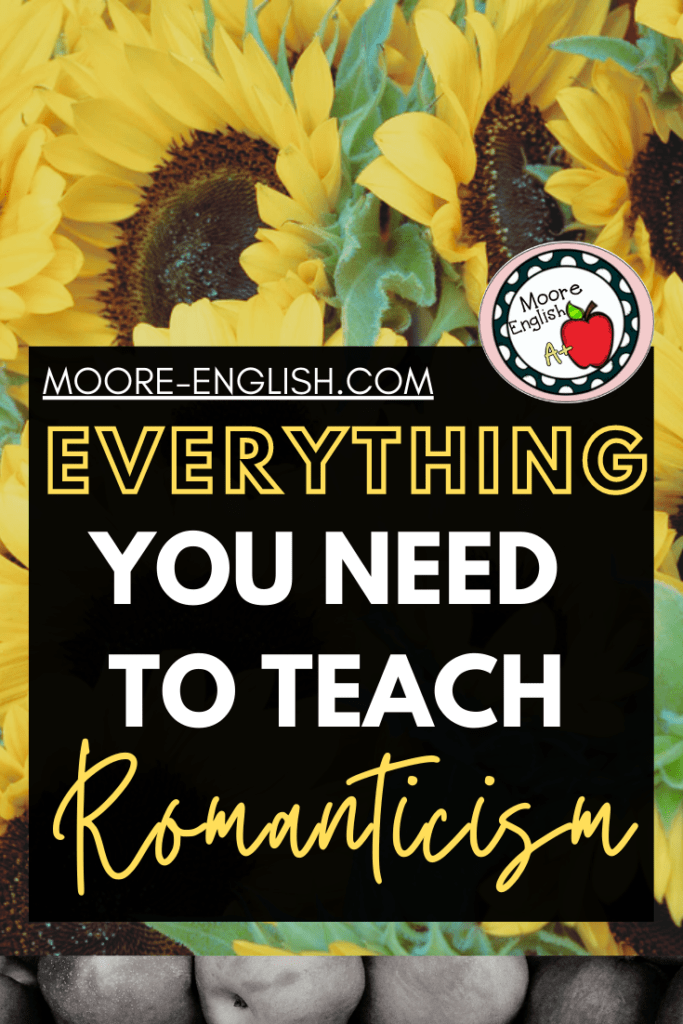
Photo by Sharon McCutcheon, Gérôme Bruneau, Gaetano Cessati, Annie Spratt, Masaaki Komori on Unsplash

